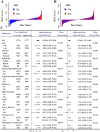Prognostic Value of Leukocyte-Based Risk Model for Acute Kidney Injury Prediction in Critically Ill Acute Exacerbation of Chronic Obstructive Pulmonary Disease Patients
- PMID: 38464562
- PMCID: PMC10923243
- DOI: 10.2147/COPD.S444888
Prognostic Value of Leukocyte-Based Risk Model for Acute Kidney Injury Prediction in Critically Ill Acute Exacerbation of Chronic Obstructive Pulmonary Disease Patients
Abstract
Purpose: Acute kidney injury (AKI) is a common complication of acute exacerbation of chronic obstructive pulmonary disease (AECOPD), and inflammation is the potential link between AKI and AECOPD. However, little is known about the incidence and risk stratification of AKI in critically ill AECOPD patients. In this study, we aimed to establish risk model based on white blood cell (WBC)-related indicators to predict AKI in critically ill AECOPD patients.
Material and methods: For the training cohort, data were taken from the Medical Information Mart for eICU Collaborative Research Database (eICU-CRD) database, and for the validation cohort, data were taken from the Medical Information Mart for Intensive Care-IV (MIMIC-IV) database. The study employed logistic regression analysis to identify the major predictors of WBC-related biomarkers on AKI prediction. Subsequently, a risk model was developed by multivariate logistic regression, utilizing the identified significant indicators.
Results: Finally, 3551 patients were enrolled in training cohort, 926 patients were enrolled in validation cohort. AKI occurred in 1206 (33.4%) patients in training cohort and 521 (56.3%) patients in validation cohort. According to the multivariate logistic regression analysis, four WBC-related indicators were finally included in the novel risk model, and the risk model had a relatively good accuracy for AKI in the training set (C-index, 0.764, 95% CI 0.749-0.780) as well as in the validation set (C-index, 0.738, 95% CI: 0.706-0.770). Even after accounting for other models, the critically ill AECOPD patients in the high-risk group (risk score > 3.44) still showed an increased risk of AKI (odds ratio: 4.74, 95% CI: 4.07-5.54) compared to those in low-risk group (risk score ≤ 3.44). Moreover, the risk model showed outstanding calibration capability as well as therapeutic usefulness in both groups for AKI and ICU mortality and in-hospital mortality of critical ill AECOPD patients.
Conclusion: The novel risk model showed good AKI prediction performance. This risk model has certain reference value for the risk stratification of AECOPD complicated with AKI in clinically.
Keywords: acute exacerbation of chronic obstructive pulmonary disease; acute kidney injury; prediction; risk model; white blood cell.
© 2024 Cai et al.
Conflict of interest statement
Min Cai and Yue Deng are co-first authors for this study. The authors declare that they have no conflicts of interest in this work.
Figures






References
-
- Halpin DMG, Criner GJ, Papi A, et al. Global initiative for the diagnosis, management, and prevention of chronic obstructive lung disease. The 2020 GOLD science committee report on COVID-19 and chronic obstructive pulmonary disease. Am J Respir Crit Care Med. 2021;203(1):24–36. doi:10.1164/rccm.202009-3533SO - DOI - PMC - PubMed
MeSH terms
LinkOut - more resources
Full Text Sources
Medical

